Some caterpillars make webs that may resemble spider webs in texture and coloring. These types of webs sever different purposes.
The species that build these webs may cover trees, plants, and other flowers in their webs.
The higher the number of webs on the tree, the higher the actual invasion risks are.
Table of Contents
Do Caterpillar Have Nests?
Caterpillars don’t have nests but they can make silk tent-like cocoons. These webs cover multiple leaves which they can safely feed in while inside.
Most caterpillars spend just a few weeks inside this silk nest, eventually moving out on their own to find more food.
Caterpillars also live in cocoons just before they metamorphose safely. A structure known as a pupa protects them as they turn into butterflies and moths from caterpillars.
A pupa should not be confused with a caterpillar web which is only aimed to keep them safe in their caterpillar stage and not in the pupating stage.
Why do Caterpillars Make Web Nests?

Multiple theories are tied to caterpillar web nests. Some say these webs are made to stop the wind and the risk of caterpillars falling from their host tree. Other theories argue these web nests are ideal for food preservation.
Food
Caterpillar web nests are made around one or multiple leaves on a tree or plant. These types of webs often cover the youngest leaves of a tree, which are the softest and the easiest to chew.
Seen as the only available food, host plant leaves are often completely eaten by caterpillars which may be responsible for tree defoliation.
The leaves of oak trees or apple trees are among the common hosts and foods inside a caterpillar web nest.
Caterpillars may live their silk tent for food when they leave inside have been eaten.
They do this towards their last instars or growth stages when they are stronger and when they need to feed more.

Shelter
Caterpillars often have no chance in front of predators such as birds and wasps. They build silk cocoons which act as a type of nest that keeps predators away.
Difficult to spot inside, caterpillars may be completely overlooked by wasps or birds in the area.
This type of structure makes them less vulnerable in their early days but they may still be vulnerable when they get out of the cocoon for more leaves.
Tachinid flies and lacewings are among the common species which may also seek out moth and butterfly eggs to eat.
Paper wasps are some of the most dangerous types of predators caterpillars try to stay away from with their web nests.
These types of wasps can eat and chew these caterpillars. Their parts are used to feed wasp larvae.
Wasps may not easily penetrate their webs on trees.

Body heat regulation
Most caterpillars aren’t very good at regulating body temperature on their own.
Cool nights can be a problem for caterpillars. As a result, they might live together in groups, warming up to each other.
These types of social groups may sometimes build nest-like webs around leaves. Multiple caterpillars can live and feed in a tent-like web which means they are always close to one another.
Wind protection
Caterpillars may use web nests to keep themselves on the leaf and not fall by accident or due to high wings.
Some species build webs to break wind while others can repel using a single silk-like thread which keeps them anchored and safe.
To prevent other caterpillars from eating young leaves
Some theories suggest caterpillars only eat the youngest and softest host leaves. There’s a limited number of new leaves on a tree or a wildflower.
This might be one of the reasons caterpillars get territorial and start covering up the leaves for themselves.
Most species may only be able to eat any type of host tree leaf in their last instars, typically after a few weeks of growth.
Caterpillars That Make Web nests in Trees
The Eastern Tent Caterpillar and The Western Tent Caterpillar are some of the most common caterpillars that make web nests in trees.
1. Eastern Tent Caterpillar

Eastern Tent Caterpillars (Malacosoma americana) are some of the most widespread species that build tents.
These silk tents offer a type of shelter for a group of caterpillars that live together.

It offers protection for the feeding period of the species. These caterpillars feed at least 3 times per day.
Rarely leaving the tent, these caterpillars may look for leaves outside of the tent but they return to the tent once they’ve fed.
The black color with blue lateral spots and brown hairs helps identify this species feeding on rosacea plants.
2. Fall Webworm

A tent-like structure protects Fall Webworm Caterpillars (Hyphantria cunea). These caterpillars remain inside the tent for most of their growth stages, up until the last instars.
Like many other species that make webs such as tents, these caterpillars also live in groups.
The young caterpillars are grouped on top of the leaves which they eat. Older caterpillars start to eat all parts of the leaves.

Fall Webworm Caterpillars remain inside the web for at least a few weeks.
These caterpillars are also known for having good communication as they may move together in synchronized movements.
3. Western Tent Caterpillar

A web is also specific to Western Tent Caterpillars (Malacosoma californica).
This is a species that grows together in a large silk web that keeps tens of caterpillars together.
Apart from keeping wasps away, this web-like tent also helps with thermoregulation.
Western Tent Caterpillars need to stay together to heat up. They only move out of the web tent when they are in their late instars.
One of the reasons they move out of the tent is due to having higher feeding needs.
4. Southwestern Tent Caterpillar
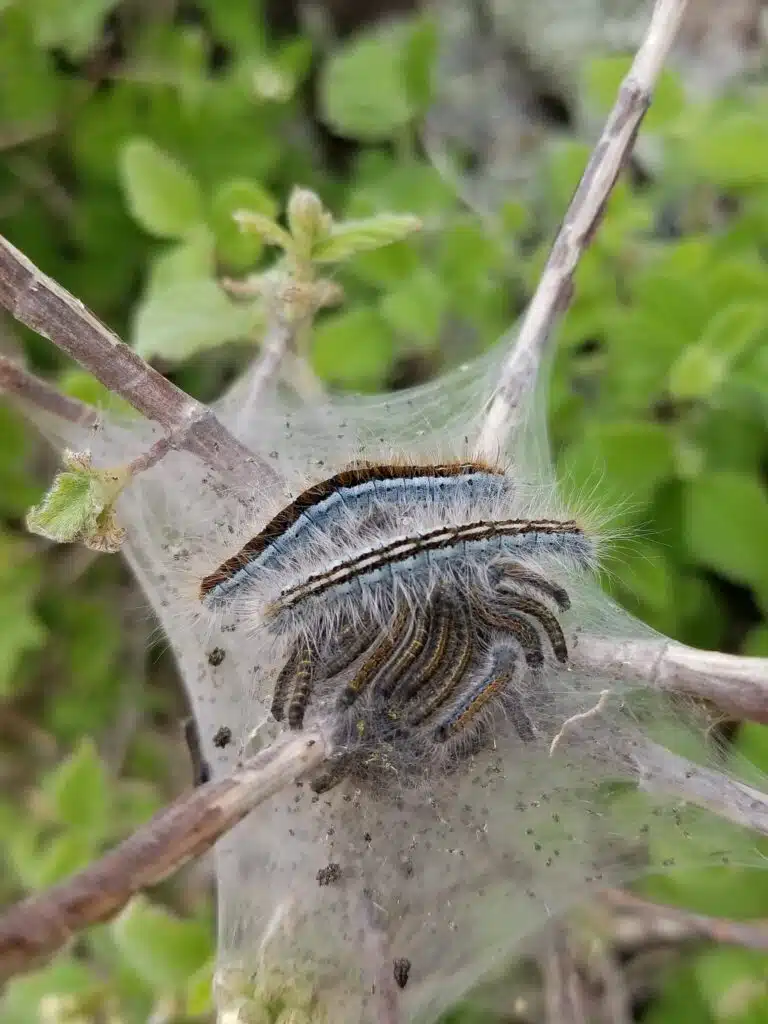
Small and large webs are made by the Southwestern Tent Caterpillar (Malacosoma incurva).
Cottonwood and willows are among the trees these webs can be seen on.
Caterpillars start feeding in a small area, slowly extending their spread across numerous branches.
Southwestern Tent Caterpillars carry a high defoliation risk.
A large invasion can lead to all of the leaves of the host tree being eaten.
These caterpillars are identified by a bright green body with black spots and gray tufts.
5. Ailanthus Webworm Caterpillar
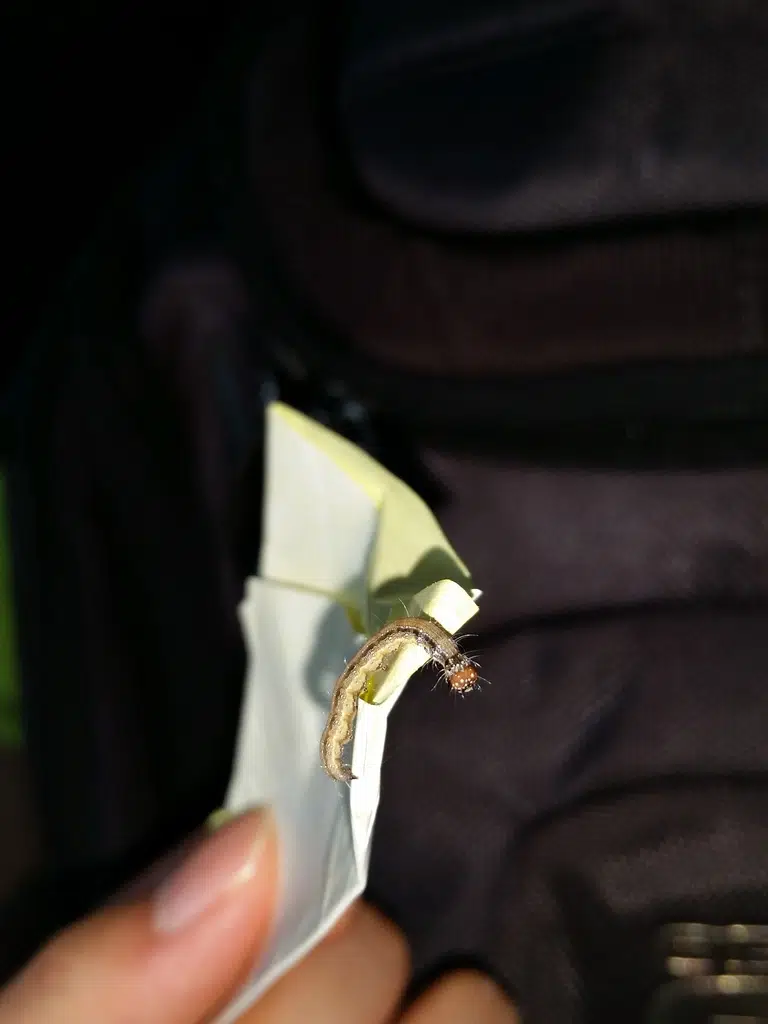
The Ailanthus Webworm Caterpillar (Atteva aurea) is a species that feeds on tree leaves. It also builds a tent-like structure with tree leaves.
Paradise trees are the main hosts of these caterpillars.

The web these caterpillars make the cover of at least a few leaves of the tree. They can also pull other leaves towards their web when they run out of food.
They have no interest in these leaves once emerged as adults as they begin feeding on plant pollen.
6. Striped Oak Webworm
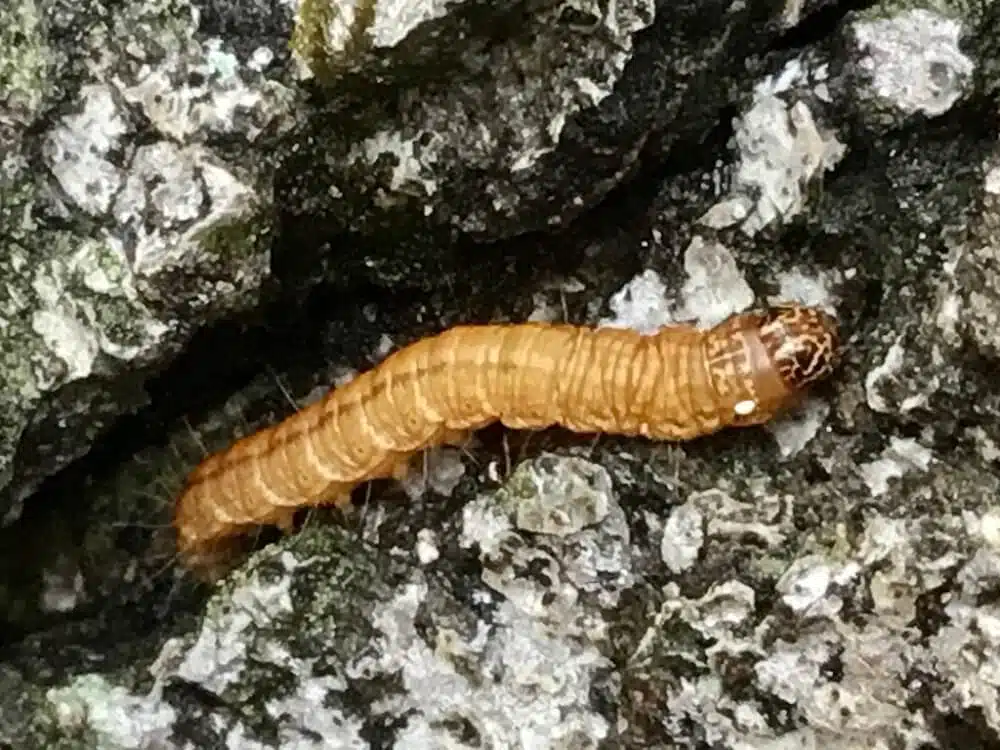
Silk webbing is made by the Striped Oak Webworm Caterpillar (Pococera expandens). These tent-like structures are the home of the species for the first few instars or initial growth stages.
They are generally their home for a few weeks which means they are filled with excrement as well.
Like other species that build webs, Striped Oak Webworms are active in groups, living social lives as they grow.
7. Pacific Tent Caterpillar

A wide range of host trees across California and the Southwest are specific to The Pacific Tent Caterpillar (Malacosoma constricta).
This is a species that feeds on tree leaves and which builds web nests around leaves.
Oak tends to be a dominant host, although it can also build its webs across all types of other hosts.
Scrub oak and Blue oak are among their common hosts. California Wildrose and Eastwood Manzanitas are among their wildflower hosts.
8. Lackey Moth Caterpillar
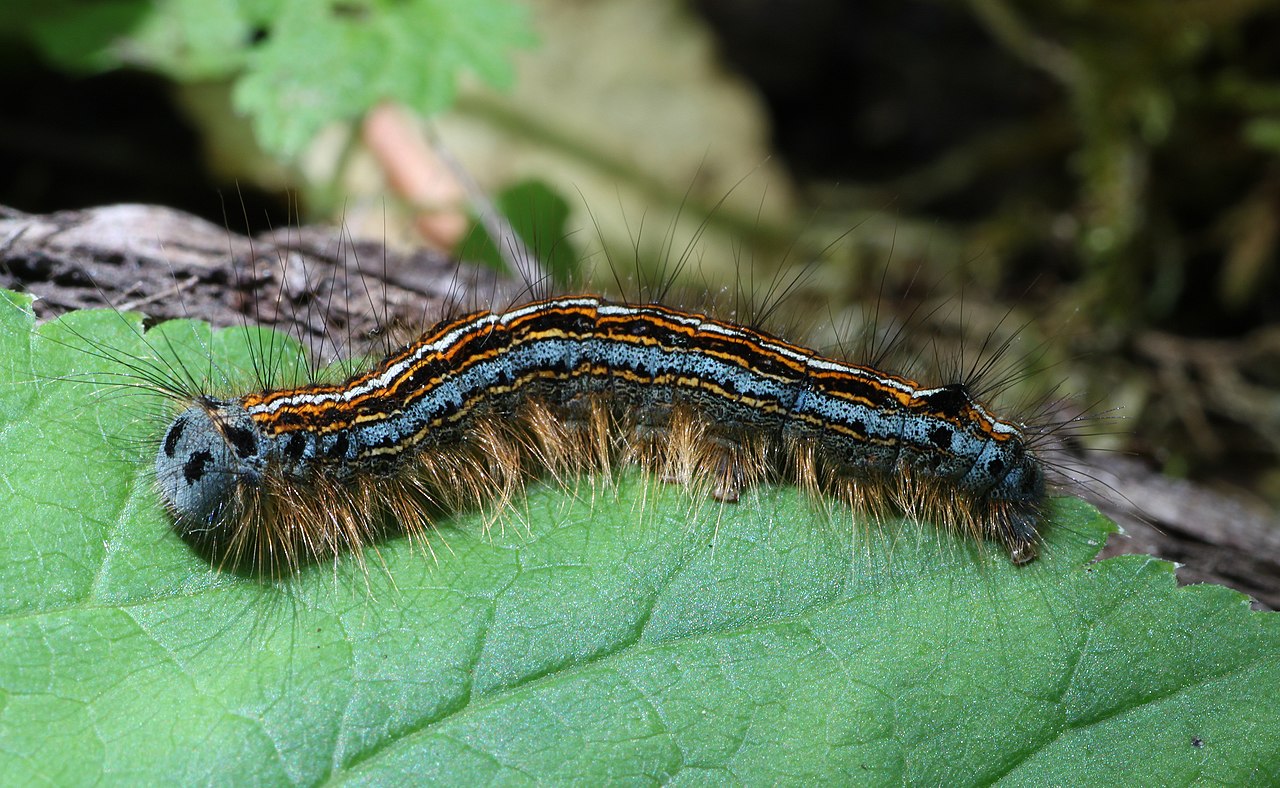
Oak and apple are among the preferred hosts of the Lackey Moth Caterpillar (Malacosoma neustria).
This species chooses the youngest and softest tree leaves to build a webbing around.
A tent-like structure is built around the young leaves these caterpillars eat as they grow.
It’s only the caterpillars that grow in a silk web as adult moths lay eggs directly on host branches but don’t cover them in a web.
9. Ground Lackey Caterpillar

An atypical type of blue-to-gray color is specific to the Ground Lackey Caterpillar (Malacosoma castrense).
This species feeds on different types of wildflowers. Some of these hosts include heather.
Tent webbing is specific to the first instars of the caterpillar. Unlike other species, The Ground Lackey Caterpillar builds a new web with each instar so that it accesses more food.
You can find this caterpillar and its webs around salt marshes.
10. Red-splashed Leafroller Moth Caterpillar
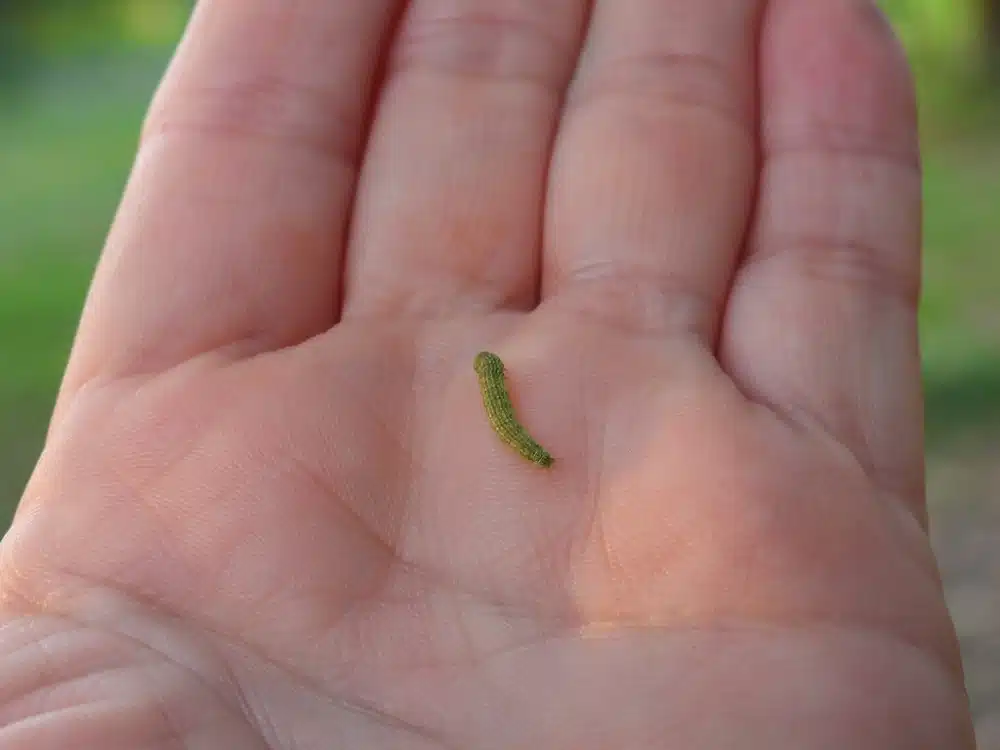
These types of green caterpillars (Sciota rubrisparsella) build webs on ornamental trees as well as on fruit trees.
Initially growing inside leaves, these types of caterpillars bring multiple leaves together in a silk tent-like webbing.
The Red-splashed Leafroller Moth Caterpillar only lives inside the webbing in its first instars.
It moves along to individual feeding in a rolled-up leaf in late instars.
Apple tree leaves and apples might be eaten by the growing caterpillar of the species.